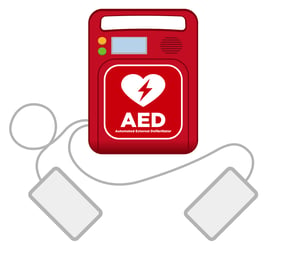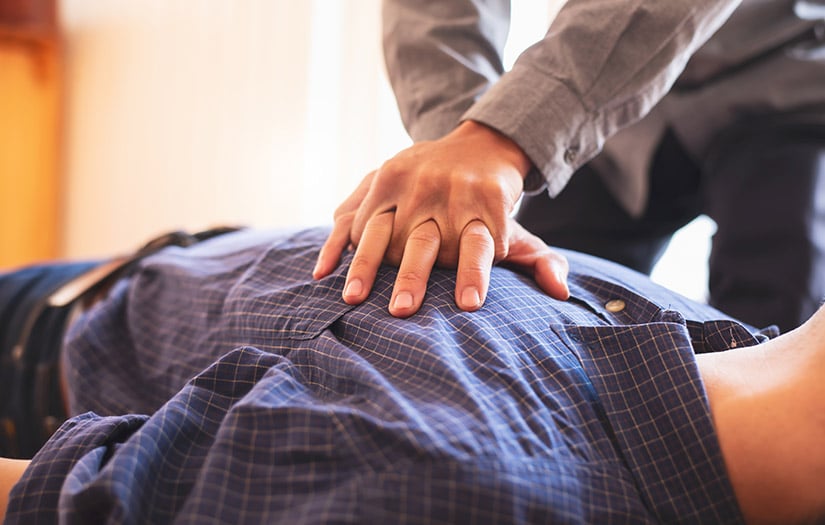Cardiopulmonary resuscitation abbreviated as CPR is an emergency procedure that is applied on individuals whose heart and lung function has stopped, or when the heart is unable to pump blood effectively around the body, such person is said to be in cardiac arrest and needs resuscitating.
Early recognition of this condition and timely provision of CPR by a bystander can help preserve the victim's life until professional help arrives. CPR keeps blood moving throughout the body.
We highly recommend everyone complete a CPR training and certification course. Below we will go over compression-only CPR the most basic level of care a bystander can perform on a victim of cardiac arrest.
If you are becoming a personal trainer with NASM, you can get your CPR certification today!
COMPRESSION ONLY CPR
Also known as 'hands-only' CPR, this involves chest compressions without rescue breaths. Untrained rescuers are advised to do this when they are present at the scene of a sudden cardiac arrest victim. Many trained rescuers also perform this procedure when they are without a breathing barrier that can protect them or the casualty from exchanging germs and infectious particles through mouth-to-mouth breathing. The presence of blood and other fluids draining from the casualty's mouth may also irritate and make a rescuer feel reluctant to give the complete dose of CPR that includes chest compressions and mouth breathes in the ratio of 30:2.
Studies have shown that adults with sudden cardiac arrest have some amount of oxygen present in their system even after the heart has stopped beating. The most important action a bystander could make in that instance is to help the heart push oxygen to the brain and other parts of the body through chest compressions.
Some conditions require a more aggressive approach such as the combination of chest compression and rescue breathing to increase the chances of survival and resuscitation.
One of these conditions can be found in cardiac arrest with delayed help; such individuals will benefit more from the combination of chest compression and rescue breath than hands-only CPR. This is because the delay in getting help would have caused depletion in oxygen levels.
Other examples can be found in victims with episodes of respiratory failure such as choking, drowning, asthma, among others before cardiac arrest. This category also needs CPR that includes rescue breathing if possible.
Infants and Children also fall under the category who require rescue breath in addition to chest compression because most cardiac arrests experienced by this group are because of respiratory failure. Our CPR training courses go further in-depth on these subjects.
In addition, covid-19 and other related infectious diseases are important reasons, while Hands-only CPR has been encouraged especially since early 2020 when the pandemic was at its peak, it forced many physical activities to be suspended. For people to continue saving lives without putting his or her lives in danger, compression or hands-only CPR is recommended and can be performed by anyone.

EASY PROCEDURES FOR HANDS-ONLY CPR
- Ensure the environment is safe by checking the scene.
- Call 9-1-1 or have a bystander call if available.
- Locate the center of the chest. Put the heel of your dominant hand on that spot.
- Put the other hand over the dominant one and interlock the fingers.
- Keep elbows locked and back straight
- Push the chest hard and fast at a rate of at least 100 compressions per minute with a depth of at least two inches.
- Continue chest compressions until an AED or medical professionals arrive.
Automated External Defibrillation: The AED
Ventricular fibrillation is a common cause of cardiac arrest; caused by disorganized electrical activity in the main pumping chambers of the heart. This condition can be treated by delivering an electric shock to the heart, which stops the disorganized electrical activity of the heart and restores normal heart rhythm.
One way to deliver this electrical shock to the heart is through an Automated External Defibrillator (AED). Turn the machine on as soon as it becomes available and follow the voice prompts.

NOTE:
It is very essential to treat the AED just like every other device that uses or generates electricity. As much as it is useful and can resuscitate an individual in cardiac arrest, it can also cause very harmful damage when abused.
As a rule for first aiders, one's safety should be considered even in the line of duty. Also, move yourself and the casualty to a safe place before using the AED especially if the casualty is close to water; the interaction between water and electricity can be lethal.
-
- If the person is wet, wipe dry quickly before applying the AED on them.
- A bulge would be noticed over the chest of those with pacemakers and other implanted devices, position the pads closer to the correct spot while also avoiding the device.
- Remove medical patch and wipe the skin dry before applying the AED pad.
YOU DO NOT NEED A CAPE TO BE A HERO, JUST KNOW CPR!
Emergencies occur everywhere, at any time, and in most cases, professional help is not always available. Everyone, regardless of profession or level of education, should be CPR certified.
It makes everyone able to take action in an emergency that might lead to saving a life. In this century, CPR certification has become a frequently needed choice in every sphere of life that most employers, including those in the non-medical profession, are taking stringent measures for employee safety and are beginning to realize the importance of this life-saving knowledge.
Cardiac arrest is a common condition in the United States, and studies have shown that more than 350,000 people suffer cardiac arrests every year. To save more lives, safety training such as CPR and AED courses has become more accessible.
ONLINE CPR CLASSES
CPR training has gone from the physical/classroom training it used to be to now offering virtual/online training so people can find it easier to learn at their convenience. This will increase the numbers of CPR-certified individuals who are willing to respond to cardiac arrest conditions outside the hospital settings.
The need to make CPR affordable and accessible to everyone necessitated the conduction of virtual CPR training by many organizations.
Online virtual training is performed through easy-to-follow text, image diagrams, and videos demonstrations. Following the same guidelines and procedures as classroom training.
PERSONAL TRAINER AND CPR/AED CERTIFICATION
Many fitness centers only hire staff who have a certain level of safety training, typically CPR/AED training at a minimum.
CPR training is now a requirement for most fitness professionals. This is because no one knows when a client will experience cardiac arrest or similar conditions that may require prompt CPR to keep them alive.
Emergencies can happen during and after training a client; people who seem to be in good health can suffer from diseases that cause cardiac arrest. Whether in the gym, at home, or out, you may be the only person who can provide CPR to a victim in cardiac arrest.
CPR/AED training provides valuable lifesaving skills. The high level of risks associated with fitness and exercise places Personal Trainers high on the list of professionals who need to be CPR certified.
Every second counts! Emergencies do not wait for you to take a certification course. Get certified today!
















